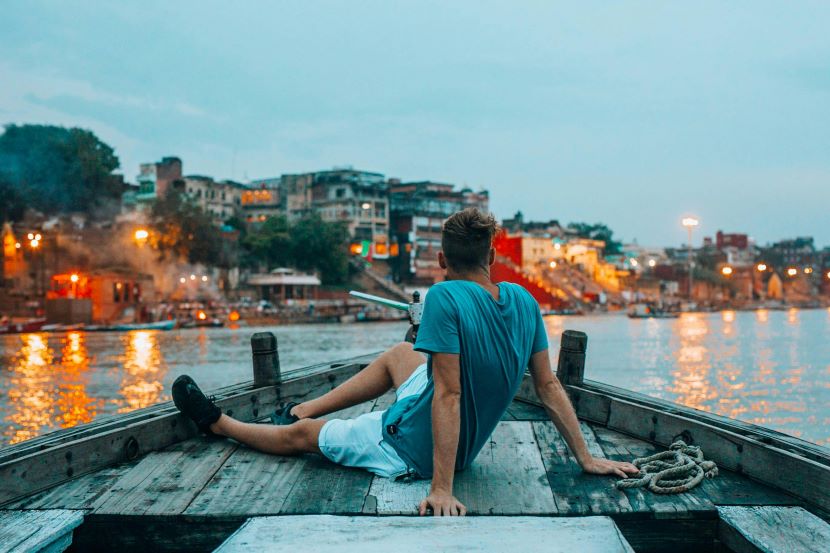Varanasi Transforms Into A Global Tourism Hotspot Redefining Cultural And Spiritual Travel In India
Varanasi transforms into a global tourism hotspot with an extraordinary rise in foreign visitors, redefining cultural and spiritual travel in India.
Once primarily celebrated as the spiritual capital of India, Kashi or Varanasi has now risen as one of the world’s most striking examples of how heritage, spirituality, and modern tourism can converge to create a blueprint for sustainable global travel. Over the last three years, the ancient city has experienced an unprecedented surge in international visitors, recording a 120-fold increase. This transformation marks a new chapter not only in the city’s history but also in India’s tourism narrative.
The Transformation of a Timeless City
For centuries, Kashi also known as Varanasi has been revered as a sacred destination that draws millions of pilgrims seeking spiritual awakening along the Ganga River. While faith has always been the lifeblood of the city, recent efforts have turned this traditional pilgrimage center into a flourishing tourism hub. The monumental increase in foreign tourist arrivals signifies a shift from seasonal visits to year-round exploration, reshaping the way the world experiences India’s heritage.
Hoteliers and tour operators have reported consistently high occupancy rates, a marked change from earlier patterns dominated by festive or pilgrimage seasons. This steady stream of visitors underlines how Kashi’s appeal has expanded far beyond its religious significance, attracting travelers interested in culture, history, architecture, cuisine, and immersive experiences.
Infrastructure Redefining Heritage Tourism
Central to this transformation has been robust infrastructure development. The revitalization of theKashi Vishwanath Corridor, improved road connectivity, upgraded ghats, and modern facilities have together made the city more accessible and tourist-friendly. These enhancements balance the delicate task of preserving heritage while accommodating contemporary travel standards.
New walkways, clean riverfronts, organized boat rides, and heritage restoration projects have elevated Kashi’s image from a congested pilgrimage destination to a meticulously managed global heritage site. Integration of efficient transportation networks, including better connectivity to Varanasi Airport and railway hubs, has also made domestic and international travel more seamless.
A Surge in Foreign Interest
The most compelling dimension of this growth story lies in the international traveler segment. Kashi has become a magnet for visitors fromEurope, the United States, Southeast Asia, and Latin America, driven by a blend of spirituality, art, and authenticity that few destinations can match. Tourists are no longer visiting simply to witness rituals along the Ganga; they are engaging deeply with the city’s traditions—through local art workshops, classical music recitals, culinary tours, and evening aartis that illuminate the ghats.
This fresh wave of travelers embodies an evolving global curiosity toward India’s intangible heritage. The increase in international visibility has been further bolstered by global travel influencers, cultural documentaries, and the city’s recurring presence in international travel itineraries and digital platforms.
The Role of Policy and Promotion
Government initiatives have played a pivotal role in paving the way for this resurgence. Focused tourism campaigns highlighting Varanasi’s fusion of ancient and modern elements have drawn global attention. The emphasis on safety, cleanliness, and hospitality is transforming perceptions of traditional Indian destinations into modern, well-managed experiences.
Collaborations between the local administration, hospitality industry, and private stakeholders have amplified this impact. The digitalization of visitor information, multilingual guides, and tourism support centers have added depth to the visitor experience. With efficient management systems and technology-driven services, the city’s tourism sector now projects reliability and sophistication alongside its timeless mystique.
Cultural Immersion and Experiential Travel
The rise of experiential travel has been another strong driver of Kashi’s global appeal. Instead of conventional sightseeing, visitors now prefer deeper engagements such as yoga retreats, Ayurveda therapy sessions, and music heritage walks. Artistic hubs in old Kashi neighborhoods showcase silk weaving, classical dance forms, and the making of traditional lamps—allowing tourists to interact with artisans who are custodians of centuries-old skills.
Even the famedGanga Aartihas evolved from a mere spectacle to an experiential highlight attracting thousands each evening. The experience of boat rides during sunrise, the mellifluous chants resonating across the river, and the interplay of light on ancient temples together create an unforgettable sensory narrative of faith and identity.
Year-Round Tourism and Economic Growth
Unlike previous decades when tourism would witness peaks only during major religious festivities, Kashi now experiences sustained footfall throughout the year. This consistent influx has fueled the local economy, benefiting hotels, homestays, street vendors, performers, and artisans. Tourism-driven employment has expanded, particularly empowering local youth and women entrepreneurs who are now active participants in running guided tours, food ventures, and craft exports.
The economic ripple effect extends beyond traditional hospitality, influencing infrastructure, transportation, and digital marketing sectors. As international attention intensifies, Kashi’s tourism ecosystem increasingly mirrors global best practices, emphasizing sustainability, eco-friendly waste management, and cultural preservation.
Modern Hospitality Meets Timeless Traditions
The city’s accommodation landscape has evolved significantly. Boutique hotels, luxury riverview resorts, and heritage homestays now coexist with traditional dharamshalas, creating a diverse lodging ecosystem catering to varied budgets. Many establishments have blended traditional motifs with contemporary comforts, offering both authenticity and convenience.
Local gastronomy has also become a major draw for visitors. From iconic street foods like kachori-sabzi and malaiyo to the refined delicacies served in modern cafes, culinary tourism has added another layer of charm to Kashi’s multifaceted appeal. The fusion of old recipes with new interpretations reflects how the city continues to evolve while staying rooted in its essence.
Sustaining the Global Momentum
The challenge ahead lies in sustaining this remarkable growth without compromising the sanctity and heritage of the city. Authorities are emphasizing responsible tourism, encouraging visitors to respect cultural norms and follow sustainable travel practices. Awareness campaigns and guided educational tours aim to sensitize tourists about the ecological and cultural value of theGanga Riverand its surrounding habitats.
Kashi’s success story offers lessons in how ancient destinations can reinvent themselves through strategic modernization while preserving their spiritual and cultural character. It also serves as an example for other heritage-rich cities across India and the world seeking to balance tradition and tourism.
The Future of Kashi’s Tourism Landscape
Forecasts suggest that this surge in foreign arrivals will continue in the coming years, supported by the city’s growing reputation as a destination for cultural depth and sustainable travel. Upcoming heritage circuits, expanded hospitality investments, and immersive digital experiences are expected to enhance the tourist journey further.
With consistent policy backing and a collective effort from the community, Kashi is now being positioned as a global model for integrating spirituality, heritage, and modernization—offering the world an experience that transcends tourism and enters the realm of soulful discovery.
The post Varanasi Transforms Into A Global Tourism Hotspot Redefining Cultural And Spiritual Travel In India appeared first on Travel and Tour World


Comments and Responses
Please login. Only community members can comment.